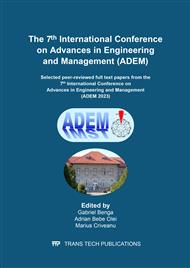p.51
p.57
p.67
p.75
p.99
p.109
p.123
p.133
p.141
Considerations Regarding Pollution Sources and their Effects on the Romanian Sector of the Danube
Abstract:
The Danube River is the most valuable ecosystem in the European natural environment. One third of the surface of the basin and half of the length of the navigable course is found on the territory of Romania. The paper aims to identify the sources of pollution existing on the Romanian sector of the Danube and the effects produced by them with an impact on altering the quality of the Danube water. The data submitted are prepared on the basis of information made available by the Territorial Administrative Units having jurisdiction sectors of the Danube River and observations, records existing in the databases of the competent authorities. Thus, the Danube is a waterway, a source of drinking water supply for the population, an important source for the irrigation system in agriculture, a source of water supply for various systems and installations in industry and last but not least, the collector of wastewater from these activities. In addition, the Danube is also the natural habitat for many species of animals and plants. The sources of pollution affecting the Danube's water quality are the most diverse and come from all fields: naval transport, industrial production units, agriculture, human agglomerations. The investments made during the last years in the modernization of existing treatment plants and the construction of new ones in the localities bordering the Danube, lead to a decrease in pollution by treating wastewater collected and processed in these plants. The consistent monitoring and in accordance with the legal provisions in force of all potentially polluting activities, the optimization of loading and unloading operations of goods in the terminals on the Romanian territory of the Danube, the handling and transport of dangerous goods in compliance with the most demanding requirements has led to an increase in the quality of the Danube water, which is of good quality, as appreciated by specialists in the field. The modernization of inland waterway vessels, continuous monitoring of the quality of wastewater discharged by industrial production units, the quality of domestic wastewater from human agglomerations, the consumption of pesticides in agriculture contributed to achieving this quality, among others.
Info:
Periodical:
Pages:
99-108
Citation:
Online since:
May 2025
Authors:
Keywords:
Price:
Сopyright:
© 2025 Trans Tech Publications Ltd. All Rights Reserved
Share:
Citation:


